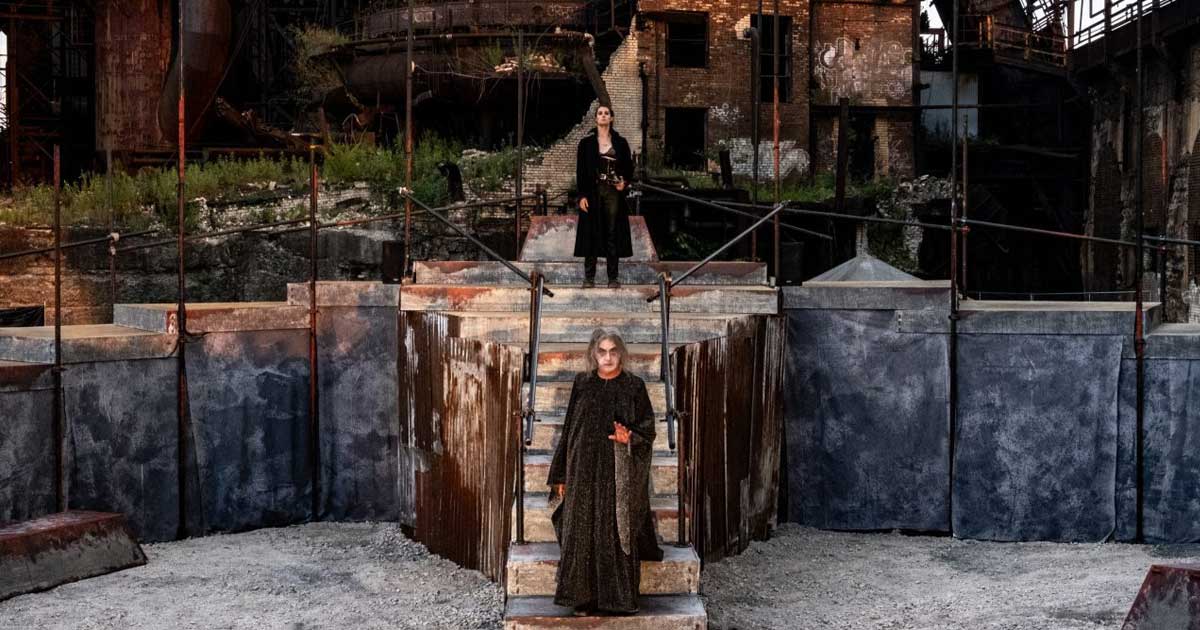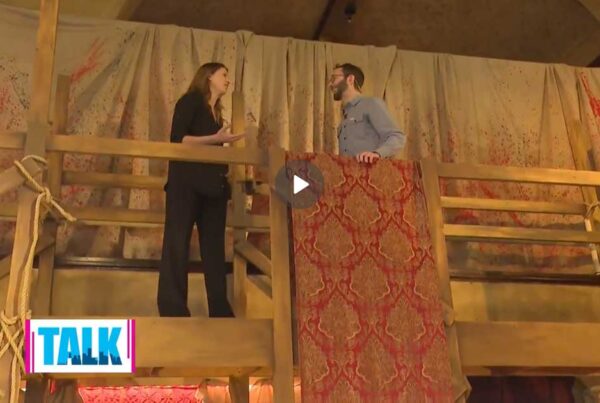
Pittsburgh Quarterly – Quantum Finds Music in an Edgy Hamlet.
In a review of a Shakespeare production several years ago I argued that, as a general rule, it has proven easier to do Shakespeare new rather than well, but with Quantum Theatre’s current production of “Hamlet,” director Jeffrey Carpenter has demonstrated that it’s possible to do both. The challenge with this play — arguably the Bard’s most enigmatic — is that even just coming up with a new way to stage it is very difficult because this is what everyone does, and has done, since Richard Burton and John Gielgud famously dressed their cast in street clothes in the 1964 Broadway version.
Although Carpenter’s costume style isn’t uniform – more on this later – the coalescing aspect of his mise-en-scène is music, with much of the play’s score performed live by various actors on a wireless, electric guitar. And not just any guitar, but a Fender Mustang, the instrument utilized by Nirvana’s Kurt Cobain, and which has become emblematic of the famous Grunge sound.
I don’t think it’s a coincidence that the set, designed by Tony Ferrieri, looks more like the backdrop for a rock opera, or an elaborate music video, than a medieval Danish castle. Especially with the gigantic, rusting, decommissioned Carrie Blast Furnaces looming in the background, bathed in purple light, as if the extraterrestrial set of the movie “Aliens” had been reimagined as an installation at the Area nightclub in 1980s New York.
It’s bold, it’s edgy, and it works, and furthermore, like the Grunge ethos, it doesn’t care if you get it or not. In fact, the Ghost (Dereck Walton) looks more like the ghost of Neil Young’s father with his long, grey, stringy hair, than the ghost of Hamlet’s father – the joke being that Mr. Young is commonly referred to as the Godfather of Grunge.
The stage is expansive and laid out like the prongs of a trident pointed at the audience, with ascending steps spread like wings on both sides of the performance area. The effect of this pushes the characters apart, forcing them to move circuitously – and vertically – rather than horizontally as across a normal proscenium stage. This has major repercussions for the actors as this tragedy, written at the dawn of the seventeenth century, gave birth to a new kind of drama, one that utilizes a form of consciousness revealing the interiority of the subjects rather than emphasizing the externality of events.
As the scholar Stephen Greenblatt explains, in “Hamlet” Shakespeare “perfected the means to represent an inwardness” which had never been done before. It enabled him “to make a play about what it is like to live inwardly in the queasy interval between a murderous design and its fulfillment.” It would take two-and-a-half centuries for literature to begin to catch up with this achievement in works such as Dostoevsky’s Crime and Punishment, and even more fully in the following century with James Joyce’s Ulysses.
But for Quantum’s cast, the staging creates the dilemma of how to reproduce this interiority, based on the inner emotions of characters, in such a copious landscape. It’s like watching a psychiatric patient lying on a Freudian couch shouting to his analyst across a football field.
Yet there is method in it. Director Carpenter trades some of the interiority for intensity, achieving poignancy with different means. Having to stage the play outside distances the audience more than would the intimacy of a theater, with all the attendant environmental filtering of wind, weather, and the ambient noise of planes, trains and automobiles (it wouldn’t be a Quantum production if at least one train didn’t pass in the middle of a character’s speech).
Hence the spectacle is made more vivid not only through the phantasmagoric lighting by C. Todd Brown, as well as the aforementioned gritty guitar accompaniment, but also in the use of wireless microphones, which is a technology we now take for granted in live theater. Ancient Greek drama was performed in acoustically brilliant amphitheaters, but hulking iron blast furnace sites do not lend themselves to such sonic acuity.
Another means to keep the intensity of the drama elevated is by the judicious editing of the text, effected by Karla Boos, Quantum’s artistic director. Uncut, “Hamlet” is Shakespeare’s longest play, comprising nearly 4,000 lines, of which the character Hamlet has about 1,500, which is more than many plays in their entirety. Thus, the performance could easily run over four hours, but Boos keeps the pacing tight without giving up much of the storyline, with the exception of the beginning. Shakespeare starts in medias res — in the middle of things — but Boos fashions a new mini play-within-the-play which compresses the death of Hamlet’s father and his funeral into a kind of “dumb-show” reenactment which, while admirable in intent, is likely to confuse anyone already familiar with the play. And a lot of people are familiar with this play, so I’m not sure its net effect is successful. Plus, this little mini-drama excises the crucial reversal manifested in the opening lines, whereby the sentinel coming on duty challenges the sentinel already in the watch tower – exactly opposite of what would be expected — which tells the audience that things are not necessarily going to unfold logically, and commensurately it adumbrates the trope of madness that will become the ethos of all the action.
In addition, Shakespeare doesn’t introduce Hamlet (Treasure Treasure) for a long 10 minutes after the action begins – a richly tantric device – but in Quantum’s version the prince appears in the first moments, along with the entire cast. Treasure’s style emphasizes the histrionic over the subtle – diametrically opposite those performances we are perhaps more used to, such as in Laurence Olivier’s 1948 film version – giving us a Hamlet who loves to shout, gesticulate, and scuttle rapidly on and off the stage; a bold choice, but ironically in contradiction to this character’s instructions to the troop of players who perform the famous play-within-the-play:
“Speak the speech, I pray you, as I pronounced it to
you, trippingly on the tongue. But if you mouth it, as
many of our players do, I had as lief the town crier spoke
my lines. Nor do not saw the air too much with your
hand, thus, but use all gently . . .”
I’m never critical of actors for the failings of technical aspects, or prop flaws, especially on opening nights; in fact small malfunctions like a dropped sword can elicit inspired improvisations. And in this performance we had a rather serious one: Hamlet’s microphone died just after the “O, what a rogue and peasant slave am I!” speech. However, Treasure handled it adroitly, when a lesser actor may have been befuddled.
In fact, the loss of amplification was almost a relief in showing how beautiful the human voice sounds on its own. By contrast, sound designer Sartje Pickett (who also composed the Grunge-flavored score) pumped so much reverb into the Ghost’s voice it actually became annoying to listen to. We get it. We know it’s a ghost. It looks like a ghost. Let the actor do his work and enunciate like a ghost. You don’t need to make him sound more quivery than a Morrissey album to convince us he’s a ghost.
Regarding the rest of the cast, Sam Turich’s Claudius is regal without appearing foppish – as he is sometimes played – and his soliloquy “O, my offense is rank, it smells to heaven” in the third act is one of the highlights of the show. Likewise, Polonius (Thom Delventhal) is another pillar of the performance, giving us an unusually nuanced evocation of a character with some of the most memorable lines in the play, who becomes all the more human and sympathetic for his meddling into his daughter’s love affair with the prince. The way he delivered the “brevity is the soul of wit” speech elicited hearty laughter from the audience.
Given much less to work with, Robin Walsh’s Gertrude is queenly and grave, eschewing the coquettish exuberance with which this character is often imbued. Her speech delivering the news of Ophelia’s death is moving and much less hyperbolic than many of the other speeches, especially those of the male characters. As to Ophelia, who is one of the hardest female roles to make convincing in Shakespeare, Saige Smith plays her demurely until she sings her “songs,” accompanied by live guitar, and takes over the stage entirely, as if none of the other players existed.
As Horatio, Hamlet’s school chum – and the original “wingman” – Brett Mack brings this often-anemic character to full-blooded life, dispelling the Latin meaning of his name which is “timekeeper.” Brendan Peifer evokes as hotblooded a Laertes as you will ever see and may singlehandedly bring the shirtless-with-suspenders look back into style. Also, Dylan Meyers (Marcellus), Dave Mansueto (Rosencrantz/Gravedigger), and Theo Allyn (Guildenstern/Clown) all contribute greatly to the success of the show.
Normally I’m a proponent of stylistic uniformity – otherwise things can end up looking random and silly – but to quote Aristotle, if one is to be inconsistent, “be inconsistent in a consistent fashion.” Hence Susan Tsu’s costumes comprise multiple eras and styles, from Claudius’ early twentieth-century white tie-cum-neo-Fascist cape, to Ophelia’s contemporary sun dress. Hamlet, in black corset, bralette, and long black coat evokes a New York Dolls vibe with Prada overtones. We also have characters in tweed jackets, British school blazers, and full riot gear with ballistic vest and helmet. A kind of madness, yes, but a madness born in craft, as Hamlet might say.
What Quantum gives us is a contemporary, post-modern, and honest production that challenges many assumptions we may have about this classic play. Its brisk pace, iconoclastic visual design, and live music kept me rapt to the point that I didn’t want the energy to stop, even during the intermission. There’s also a healthy bit of camp to balance the inherent tragedy. You know a show has been successful when you leave fulfilled but are still sad the experience is over.
Many people deconstruct “Hamlet” looking for universal motifs in the Dane, when he is one of the most individuated characters in Western literature. Others use him as a polemicist for a particular cause or world view. As Quantum proves, you don’t always get the “Hamlet” you expect, but if you listen closely to what Shakespeare wrote, you always get the “Hamlet” you need. The only thing Hamlet can be said to exemplify is humanness; the rest is noise…




